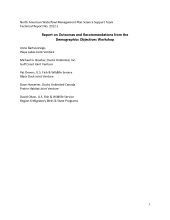
ABSTRACT
In 2009, the NSST Alternative Performance Metrics (APM) Committee identified a limited number of alternative performance metrics to be adopted and implemented by the NAWMP Committee and Joint Ventures (NSST Technical Report 2009-1). The APM Committee developed guidance for advancing beyond financially and area-based objectives and accomplishment metrics to those more meaningful for assessing biological impacts of conservation actions.
Although development of these recommendations represented a significant accomplishment, tangible advancements in measuring biological effectiveness of conservation actions will occur only if the recommendations are adopted by the NAWMP community. The NSST identified as a priority item in its 2012 – 2016 Work Plan the need to continue shepherding these recommendations and to facilitate their implementation. Thus, the NSST Demographic Objectives Committee was established in 2010 with the primary goal of developing methods for setting demographic objectives (i.e., vital rates) at BCR/JV-scales for focal waterfowl species.
The NAWMP Science Support Team’s (NSST) Demographic Objectives Committee convened a workshop on 14-15 June 2011 in Corpus Christi, Texas to solicit input from Joint Venture representatives on their efforts to establish regional-scale demographic objectives, logistical and technical challenges to doing so, and opportunities and strategies to expedite the surmounting of those challenges. To catalyze workshop discussions, each attending JV representative was asked to deliver a presentation describing the biological models used to establish waterfowl habitat objectives within their region and the extent to which their models were linked to vital rate objectives. Primary objectives of the workshop were to: 1) provide peer review of current JV biological modeling approaches; 2) establish a commitment from JVs to begin developing demographic objectives within the next 5 years where they do not already exist; and 3) develop a clear understanding of the most appropriate strategies for measuring habitat conservation impacts on key vital rates.
Workshop recommendations for establishing objectives and measuring accomplishment in terms of demographic rates are included in this report and are summarized as follows: promote completion of pintail, scaup, and black duck annual cycle models; develop an annual cycle model for a generic dabbling duck, perhaps based on mallard demographics; and develop strategies to communicate the value and utility of integrated annual cycle models and demographic objectives.
